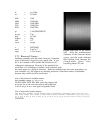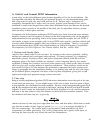3.9. Analytical Pupil Functions
POEMS knows about the following analytical pupil functions:
GAUSSIAN TEM
00
Gaussian beam
AIRY Uniform circular disc pupil function, resulting in an Airy function at
the focus E=2J
1
(krNA)/(krNA), the jinc function.
FLATTOP Pupil function is a jinc times a circularly-symmetrical Hamming
window, resulting in a focused beam with a flat top and smoothly
sloping sides. The actual pupil function is
E(u,v)=2(0.54+0.46cos(πρ))J1(6πρ)/(6πρ), where ρ=(u
2
+v
2
)
1/2
/NA.
3.10. Material Parameter Functions
These functions are linearly-interpolated values generated from tables in Palik & Ghosh,
Optical Constants of Materials. They are parameterized by wavelength in metres, and are
in general much more precise than they are accurate. It isn’t that the measurements are
bad, or that the interpolation is too crude, it’s just that they describe measurements on
particular films prepared with extreme care. Most optical devices are made with films
whose density is not 100%, whose structure is columnar rather than amorphous or
crystalline, and whose stoichiometry is far from perfect, so these values may not
accurately predict the refractive indices of your actual materials. "Optical constants of
thin films" is an oxymoron, so don’t take these values too seriously.
These discrepancies are perhaps most serious in the case of fused silica. Commercial
fused silica usually contains some OH groups due to the silane flame deposition
technique used to make fused silica boules. These OH groups are harmless in the visible,
but out at 2 µm and beyond (especially near 2.7 µm) they may make the material almost
opaque, even though the function SiO2_K() predicts low absorption there. (The best
infrared-grade fused silica is indeed transparent in this region.) Of course, given the
memory and processor speed constraints of current machines (say 2 GB and 3 GHz), the
opacity of OH hasn’t much of a chance to be felt within the bounds of a FDTD
simulation.
Au_N(lambda), Au_K(lambda) Gold 0.5636 — 5.166 µm
Ni_N(lambda), Ni_K(lambda) Nickel 0.5636 — 5.166 µm
Cu_N(lambda), Cu_K(lambda) Copper 0.5636 — 5.166 µm
Si_N(lambda), Si_K(lambda) Crystalline silicon 0.5636 — 5.166 µm
aSi_N(lambda), aSi_K(lambda) amorphous silicon 1.03 — 1.52 µm
SiN_N(lambda), SiN_K(lambda) Silicon Nitride under construction
SiO2_N(lambda), SiO2_K(lambda) Fused silica 0.5636 — 5.166 µm
Corning1737_N(lambda), Corning 1737 glass 0.4360 - 1.541
µm"
48


















